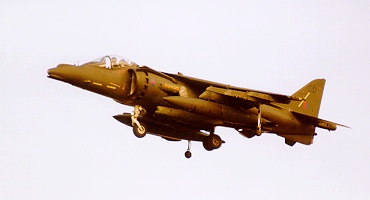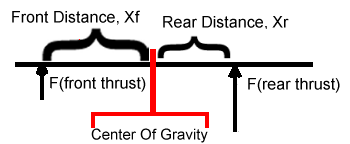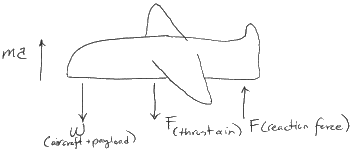 |
 |
| VECTORED THRUST JET ENGINES | ||
| QUESTIONS OR COMMENTS | ||
 |
AUTHOR: | Kevin Richardson |
| E-MAIL: | kevrich@mit.edu | |
| COURSE: | 2 | |
| CLASS/YEAR: | 2 | |
MAIN FUNCTIONAL REQUIREMENT: Provide vectored thrust
DESIGN PARAMETER: V/STOL (vertical/short takeoff and landing)
(type of aircraft engine which uses a thrust of air to lift aircraft straight up)
GEOMETRY/STRUCTURE/FUNCTION:
A Harrier jet can takeoff or land vertically because the jet engine provides a stream of fast moving air through nozzles attached to the side of the engine. A system that controls the rotation of the nozzles directs the air (thrust) downward. The thrust (for our purposes, thrust is synomous with force) downward is opposed by a reaction force upward. This reaction force counteracts the weight of the aircraft and its payload enabling vertical acceleration. First, let’s see how the jet engine provides the air stream.
Jet Engine
- Air passes through the fan and LP (low-pressure) compressor system.
- Some air is channeled into the HP (high pressure) compressor system while the rest of air becomes a cold stream of air that is funneled to a pair of nozzles in the front to provide half of the engine thrust.
- After air passes through the HP compressor system and combustion chamber, the hot air stream is directed into a pair of nozzles at the rear of the engine for the other half of the engine thrust.
 Courtesy of Gulture Enterprises; © Gulture Enterprises |
 |
| Low and High Pressure Compressor Systems in VSTOL | |
The hot air stream will be directed out of the rear nozzles at a higher velocity caused
by the HP/combustion system than the cold air stream from the front nozzles. Via Reynold’s Transport Equation for the Law of Conservation
of Momentum, one can show the force due to the moving air
stream equals the product of the area of the air stream, the
density of the air, and the velocity of the air squared.
F(thrust) ~ Area(air stream) * Density(air) * Average Velocityair2
Therefore, the rear thrust will be greater than the front thrust because it has a much greater velocity. The area of the air stream remains the same
at the front and rear nozzles. To eliminate imbalance along the horizontal plane of the
aircraft, the rear thrust must be closer to the center of gravity of the aircraft and the
front thrust farther from the center. This would balance the opposing moments
F(front thrust) * Xf = F(rear thrust) * Xr
 |
| Moment Diagram Of VSTOL and Harrier Jet |
Nozzle Actuation System
|
|
 |
| Power Transfer Mechanisms in VSTOL |
DOMINANT PHYSICS:
During vertical takeoff, the engine provides a fast-moving stream of air which is directed downward by the four nozzles. The stream of air creates a reaction force. This upward reaction force counteracts the weight of the aircraft/its payload and achieves positive vertical acceleration. The maximum weight of the aircraft and its payload is approximately 18,950 lbs.
F(reaction force from the air stream of the engine) = F(weight of aircraft and payload) + m(mass of aircraft and payload)*acceleration
 |
| Moment Diagram Of VSTOL and Harrier Jet |
Courtesy of Gulture Enterprises © Gulture Enterprises |
During short takeoffs and landings, the thrust of the engine is aided by the lift of the wings like traditional aircraft, which increases the payload capacity of the aircraft (31,000 lbs.). The four nozzles are positioned the same way as in vertical takeoff. During regular flight, the nozzles are turned horizontally directing the thrust like a conventional aircraft. |
LIMITING PHYSICS:
The performance of the V/STOL operations is dependent upon the payload of the aircraft. The speed of VSTOL operations depends on how much weight is supported by the vectored engine thrust (i.e. how much thrust is used to fly the craft vs how much is used to keep it airborne).
PLOTS/GRAPHS/TABLES:
None submitted
WHERE TO FIND VECTORED THRUST ENGINES:
Rolls Royce Pegasus 11 vectored thrust turbofan engine, the current vectored thrust engine designed for a one-seater aircraft, provides up to 21,500 lb. static (vertical) thrust, and is incorporated into the AV-8B Harrier Jet. The engine was used extensively by the US Marine Corps in the Gulf War, and by air forces around the world. The engine allows the aircraft to reach transonic speeds and a range of around 2,000 miles.
REFERENCES/MORE INFORMATION:
Myles, Bruce, Jump Jet: The Revolutionary V/STOL Fighter, Brassey's Defence Publishers, London, 1986.
Fozard, John, The Jet V/STOL Harrier, Kingston-Brough Division, 1978.
How a Vectored Thrust Engine Works